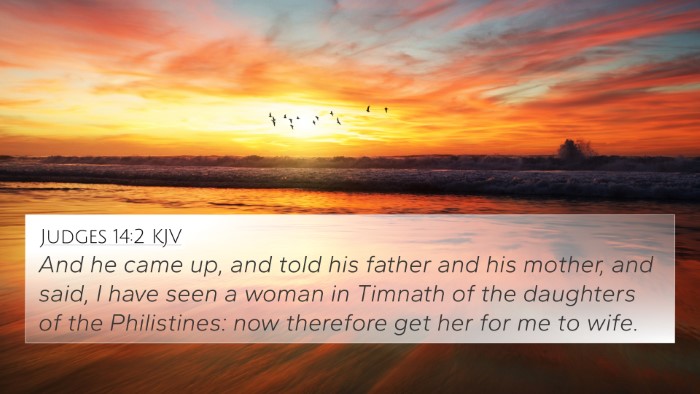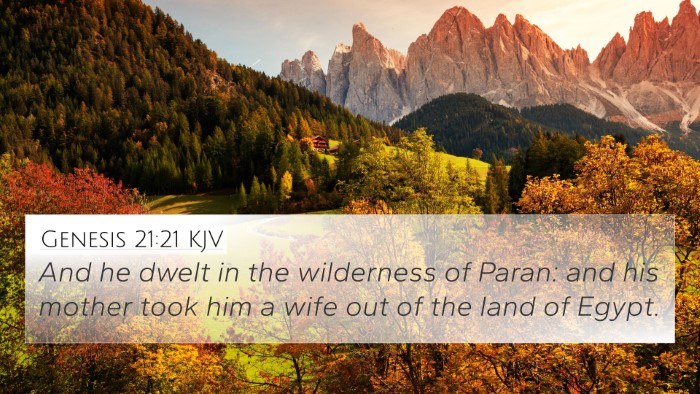Understanding Genesis 34:4
Genesis 34:4 states: "And Shechem spoke to his father Hamor, saying, 'Get me this girl as my wife.'" This verse details an interaction following a significant event in Jacob's family, specifically concerning Dinah, Jacob's daughter.
Contextual Overview
In the narrative, Dinah is encountered by Shechem, the son of Hamor the Hivite. The events that follow are pivotal in elucidating themes of love, desire, and the implications of inter-tribal relationships in biblical history.
Commentary Insights
Various public domain commentaries provide valuable insights into this passage:
-
Matthew Henry:
Henry emphasizes the consequences of passion unchecked by moral restraint, noting how Shechem's desire leads to significant strife and moral implications for both families involved. He presents this act as an example of the dangers that arise when familial boundaries are transgressed.
-
Albert Barnes:
Barnes elaborates on the cultural and societal implications of Shechem's request, pointing out that intermarriage was a common practice in ancient societies but often came laden with conflicts and complications, especially between different tribes. He also highlights the potential motivations behind Shechem's desire, suggesting it may stem from a complex mix of genuine affection and societal pressure.
-
Adam Clarke:
Clarke offers a perspective on the character dynamics at play. He interprets Shechem's action not merely as lustful but suggests it carries the weight of a strategic alliance. His analysis draws attention to the desire to intertwine their families, which was often a tactic for peace among tribes, albeit one that can lead to deep-seated animosities.
Key Themes
This verse encompasses several key themes:
- Desire and Request: The interaction showcases the balance between desire and the reality of the situation.
- Interpersonal Relationships: It explores the dynamics between different groups and the impact of personal relationships on broader societal ties.
- Family and Community: The verse highlights the importance of family in cultural contexts and how relationships can forge or fracture community bonds.
BIBLE CROSS-REFERENCES
Genesis 34:4 connects to various other scriptures, showcasing thematic and narrative parallels. Notable cross-references include:
- Genesis 34:2 - Dinah's defilement by Shechem, setting the stage for the subsequent actions.
- Genesis 34:7 - The reaction of Dinah's brothers, highlighting themes of protection and vengeance.
- Exodus 34:16 - Laws regarding marrying foreign women and the potential consequences.
- Deuteronomy 7:3 - Explicit instructions against intermarriage with surrounding nations.
- Judges 14:1-3 - Samson's desire for a Philistine woman; a similar theme of crossing cultural boundaries.
- Ezra 9:1-2 - Concerns in post-exilic Israel over intermarriage and the effect on identity.
- Matthew 10:36 - Commentary on family dynamics, particularly how familial interests can lead to conflict.
Conclusion
Genesis 34:4 serves as a profound exploration of human desires, the dynamics of family, and the cultural implications of intermarriage. Through careful analysis and cross-referencing with other biblical passages, we can gain a deeper understanding of the theological and moral lessons embedded in this narrative.
Practical Applications
When studying this verse, consider the following:
- Reflect on how the principles of desire and moral responsibility apply in contemporary contexts.
- Examine the consequences of crossing cultural and relational boundaries, both in biblical times and today.
- Develop an understanding of how interconnections between various scriptures can reveal deeper theological truths.
Study Tools and Resources
To deepen your understanding and facilitate further cross-referencing in your study, consider utilizing:
- Bible concordances for thematic connections.
- Cross-reference Bible study guides for detailed explorations.
- Online tools for identifying connections between different scriptures.
- Comprehensive Bible cross-reference materials for extensive cross-referenced themes.





